Mark Sisson's Blog, page 72
May 29, 2020
Weekly Link Love – Edition 83

Research of the Week
Diabetic patients taking metformin had lower coronavirus mortality than diabetic patients not taking it.
“Increased cardiovascular disease in African-Americans with Covid-19.”
Unsaturated fat intake and deficiencies in calcium and albumin linked to higher coronavirus mortality.
New Primal Blueprint Podcasts
Episode 425: Robert Glazer: Host Elle Russ chats with Robert Glazer, founder and CEO of the global performance marketing agency Acceleration Partners.
Primal Health Coach Radio, Episode 62: Laura and Erin talk with Dr. Jade Teta about metabolism and hormones.
Media, Schmedia
Women are not just men with “boobs and tubes.”
Who’s still getting sick in New York?
Interesting Blog Posts
Social Notes
How to slow down time (seriously).
Everything Else
“The human voice contains information about dynamic bodily states.”
ApoE4 gene predicts severity of coronavirus infection (in the UK).
A beautiful video about traditional wool clothing. Best part is how they “shear” the sheep without cutting the wool. Looks so satisfying.
Things I’m Up to and Interested In
Fascinating article: How loners help species survive.
Interesting result with big implications for hunger: High-carb meal results in initial increase in available energy followed by a drastic crash.
Great turn of phrase: Fructoholism.
Fact I was unaware of: Mice and many other animal models used in studies do not depend on vitamin D for their innate immune circuitry.
My favorite paradox: High-fat dairy linked to better health, again.
Question I’m Asking
How much nature are you getting these days? (get some)
Recipe Corner
Energy balls your vegan and paleo friends will love.
Some people need to be careful with raw broccoli, but if you can handle it, try this broccoli salad with bacon.
Time Capsule
One year ago (May 24 – May 30)
4 Mushrooms You Need to Know – Fungi are not fungible.
The Keto Carb Threshold: What Constitutes a “Keto” Meal– Well, what does?
Comment of the Week
“A note about sunglasses: Some folks should be wearing them. For instance, a lot of the fisherman in native tribes would go blind at a fairly early age from staring into the water for long periods of time. The Eskimos had really cool bone sunglasses, with little slits they would use, so they would not go snowblind. After my own daily sun exposure, I’m not averse to putting on my shades.”
– Nicely said, Nocona.
The post Weekly Link Love – Edition 83 appeared first on Mark's Daily Apple.



May 28, 2020
Ask a Health Coach: How to Go Primal, Why We Crave Sugar, and Loving Your Body As-Is
In this week’s edition of Ask a Health Coach, Erin answers more of your questions from the Mark’s Daily Apple Facebook group. She’ll be discussing strategies on the best way to go Primal, the real reasons we crave sugar (and what to do about it), and what happens when we all go back to work and have to wear real clothes. Got more questions? Keep them coming on the MDA Facebook page or in the comments below.
 Michael asked:
Michael asked:
“I’m planning on starting the Primal Blueprint next week. Better to dive in 100% or do it more gradually?”
As you might have guessed, some people do great diving right in, while others find it too overwhelming and have more success with a gradual approach. I think the bigger question we need to ask here is: what will make you stick with it for the long term?
For the record, the Primal Blueprint isn’t a diet or a workout routine — two things that have “short-term” written all over them. It’s not an all-or-nothing approach either. The Primal Blueprint is based on an 80/20 principle that allows you to abide by the theories of ancestral living without worrying about a French fry here or a glass of red wine there.
The key is to know yourself well enough to understand what works best for you. Do you have proof that you’re better going cold turkey rather than dipping your toe in? Or maybe you’ve always been more successful taking baby steps. Look at all the areas of your life — all the times you thrived when there was zero room for negotiating versus not wanting the pressure of everything needing to be perfect 100% of the time.
There’s not a ton of research out there about which is better, but this study 1shows that you’re more likely to stick with a new diet and exercise routine by making small changes. However, this study 2 contradicts that finding, saying that going all out in the beginning can influence how well you do in the long-term.
For some, the immediate reward of dropping a bunch of water weight with an all-in approach can be really gratifying. For others, starting gradually can feel less scary and more comfortable.
No matter which way you decide to pursue it, it’s important to be 100% committed to the changes you’re making, knowing that 80/20 doesn’t mean you have a free pass to binge on ice cream or stay out late 20% of the time. And if you’re not totally committed, you might be better off taking a step back to figure out why this change is important to you in the first place.
Suzanne asked:
“I know sugar is bad for me, but why do I crave it so much?”
Since you’re already aware of sugar’s health-degrading properties, I’ll save you the lecture and the research. But you bring up an interesting question. Why do we crave it so damn much?
Any kind of emotional or psychological dependence on sugary foods, or even foods that convert to sugar in the body is classified as a sugar addiction. So, we’re on a similar playing field to other addictions like cigarettes, drugs, and alcohol.
Sugar provides a quick fix 3 that takes the edge off a stressful day. It makes staying at home under quarantine a little more bearable. And gives us a jolt of dopamine, even if it’s only temporary.
The reason we crave it so much is because it allows us to cope. It helps us change our reality (or our perception of our reality) in the moment. That need to want to change where we’re at is so strong sometimes, it overrides our innate knowledge that sugar is bad for us.
Three main reasons we crave sugar:
Stress. The more stressed out we are, the more intense cravings can be. Think about healthier ways you can relieve your stress like doing a few minutes of diaphragmatic breathing 4 or going for a walk outside before choosing to rip through a bag of M&Ms.
Sleep. Skimping on sleep can send you looking for a hit of energy 5 before most people log into their first Zoom meeting of the day. When you eat sugary meals like pancakes, cereal, or even a fruit-on-the-bottom yogurt, you’ll end up feeling more tired as soon as your blood sugar starts to crash.
Emotions. What thoughts, emotions, people, or places bring on your cravings for sugar? The more awareness you can have on these subjects, the better off you’ll be — and the fewer cravings you’ll have to deal with.
Jenny asked:
“Ok. I’ve really let myself go these last few months. Any tips for getting back on track? You know, for when I have to wear real clothes again?”
Here’s an idea. Love where you are, right now. And if you can’t do that, try giving it some respect. Now, before you start rolling your eyes, hear me out. The human body is an incredible, multifaceted, miraculous organism that keeps you alive. It effortlessly adapts to the nutrient-dense foods and fresh air you give it — and just-as-effortlessly course-corrects when you inevitably mess it up. So, the least you can do is show it some appreciation.
Micromanaging your macros, obsessing, or forcing your body to look like it did 10 years ago or 10 weeks ago is a serious waste of time. Trust me.
I spent way too many years wishing some parts of my body were smaller, wishing some were bigger, and hating on my stretch marks and dimples; and I regret those years of lost joy. It can be hard living in a world that’s obsessed with “perfect” physiques, but here’s the thing. Your body is already perfect as-is. It knows how to breathe. How to pump blood through your veins. And how to let you know when it needs fuel. Frickin’ amazing!
The time we spend bad-mouthing our already perfect bodies is unbelievable. So what if you’ve gained a few pounds or got softer in a few places? Instead of focusing on the parts that might have changed over these past few months, start loving on the ones that have kept you alive all these years. And if you can’t love on them, at the very least, start respecting the hell out of ‘em.
References https://www.ncbi.nlm.nih.gov/pmc/articles/PMC5644785/https://www.ncbi.nlm.nih.gov/pmc/articles/PMC3780395/https://www.nature.com/articles/s41598-019-53430-9https://www.ncbi.nlm.nih.gov/pmc/articles/PMC5455070/https://www.psychologytoday.com/us/blog/sleep-newzzz/201912/the-connection-between-sugar-and-your-sleep
The post Ask a Health Coach: How to Go Primal, Why We Crave Sugar, and Loving Your Body As-Is appeared first on Mark's Daily Apple.



May 27, 2020
The Definitive Guide to Sun Exposure
 The ancients prayed to it. Farmers relied on it. The seasons depend on the earth’s tilt toward it. The sun is always up there, shining down, filling the world with light and heat, sending down powerful rays of energy that scatter across the surface, sneak through windows, penetrate otherwise dark caves. You can’t avoid it, unless you shut yourself inside, draw the blinds, and close your eyes.
The ancients prayed to it. Farmers relied on it. The seasons depend on the earth’s tilt toward it. The sun is always up there, shining down, filling the world with light and heat, sending down powerful rays of energy that scatter across the surface, sneak through windows, penetrate otherwise dark caves. You can’t avoid it, unless you shut yourself inside, draw the blinds, and close your eyes.
That’s what we’re supposed to do: avoid it. “Any amount of sun exposure is unsafe,” according to the experts, and will give us skin cancer. They tell us it’s a toxin. If we have to be outside, we’d better slather on the sunscreen, wear a hat that shields our entire body, and avoid the harsh midday sun at all costs.
And yet, for hundreds of thousands of years of human evolution, we couldn’t avoid it all the time. We were exposed to the sun when we hunted, when we gathered. When we fished, dug, fought, climbed, and explored. The intensity of our sun exposure varied according to the climate, the latitude, the time of year, and we weren’t out there tanning, but it was always around. Exposure occurred to some degree on a daily basis. We are adapted to the sun, like most other life on earth. We aren’t just able to withstand it. We can derive vital benefits from our exposure to it. We need the sun in a direct way.
Today I’m going to tell you why we need sun exposure, what the benefits are. I’m going to tell you how to make it safe, how to avoid sun damage, and the best time of day to do it. I’ll discuss too much sun and too little. I’ll give you safe ways to block the sun and reveal the unsafe ways to avoid.
First, what’s so good about sunlight?
Benefits of Sunlight
The benefits of sunlight include:
Vitamin D
Nitric Oxide
Circadian Rhythm Entrainment
Immune Health
Cognitive Function
Eye Health
How does this all play out?
Vitamin D
Sun exposure causes the skin to produce vitamin D, a “pro-hormone” that regulates sex hormone production, immune function, bone, dental, and heart health, cancer prevention, and gene expression—to name a few functions. In other words, it’s one of the foundational compounds in the body, an extremely vital substance. We can get it from food or supplementation, but getting it from sunlight is auto-regulatory. It’s extremely hard to overdose on sun-induced vitamin D production, whereas you can overdo supplemental vitamin D (although even that is hard).
Nitric Oxide
Nitric oxide modulates the function of our endothelial system—the veins and arteries. Nitric oxide literally widens blood vessels and arteries, thus increasing blood flow to tissues (and the amount of nutrients that blood carries to those tissues). It even reduces blood pressure, improves our cardiovascular health, and is extremely important for our overall health, well-being, and physical performance.
It turns out that sun exposure increases nitric oxide production in the body.1
Circadian Rhythm
We need exposure to light at certain times of the day in order to regulate our sleep-wake cycle – our circadian rhythms. Without daytime/morning light, or with too much evening light, our internal clocks – and general health – go awry. Getting outside in the sun (even in winter) as early as possible is an effective and quite possibly necessary way to establish a healthy circadian rhythm. Plus, the more sunlight you get in the first half the day, the more resistant you will be to circadian disruption by artificial light at night.
Immune Health
Sunlight doesn’t just improve immune health by way of increasing vitamin D. It also has direct, immediate effects on immune function: increasing hydrogen peroxide production by and motility of T cells in the skin. T cells can use hydrogen peroxide to engulf and destroy pathogens, and increased motility improves their ability to move around and find pathogens to destroy.2
Cognitive Function
This study can’t determine causation, but high sun exposure is strongly linked to better cognitive function among Chinese elderly and we have reason to believe there’s a real effect here.3 For one, the vitamin D you produce in response to sunlight does boost cognitive function, particularly in the elderly (that’s been tested in clinical trials using vitamin D supplementation).4
Eye Health
Most people only think about sun exposure in terms of skin health, but it can also play an important role in the health and function of our eyes. This makes sense when you think about evolutionary precedent: just like humans evolved without chemical sunscreens blocking the sun from reaching the skin, we never wore sunglasses preventing the light from hitting our eyes. If our skin is adapted to a given level of sun exposure, so too are our eyes.
As it turns out, children who get inadequate outdoor time throughout their early lives have an increased risk of myopia.
Avoiding Sun Damage and Practicing Sun Safety
Sun exposure offers many benefits, and the conventional wisdom that sunlight is a toxin is clearly incorrect, but it’s not completely harmless. There is such a thing as excessive sun exposure. Skin cancer can happen. Burning occurs. These are bad. How can you avoid sun damage?
Avoid burning.
Sunburns are just bad. They shouldn’t happen. And if they do happen, damage has occurred. Sunburn history is a strong predictor of skin cancer risk.
This means watching your exposure time, but it could mean finding shade, wearing hats, putting on clothing, or even wearing sunscreen. More on that last one in a later section.
Get full sun, not window-filtered sun.
Getting a window desk isn’t the same as being outside in the sun. Windows filter out the UVB and allow the UVA to pass through. This has two major problems. First, UVA without UVB degrades vitamin D and fails to produce any more. You need UVB to make vitamin D. Second, UVA promotes melanoma while UVB protects against it.
Get good sleep.
Our resistance to the sun follows a circadian rhythm, with our defenses strongest in the first half of the day. So you might not want to go tanning after an all-night bender, nor do you want to get too much UVA-rich sun in the late afternoon when your defenses are down.
Chronic over acute.
You know who’s less likely to get melanoma? The person with “occupational” sun exposure—the lifeguard, the surfer, the outdoor laborer. You know who’s more likely to get melanoma? The person with “intermittent” sun exposure—the holidayer spending a couple weeks baking on a beach in Hawaii every year, the indoor office worker who tans for hours on the weekend. The intermittent type is more likely to get sunburned, more likely to get too much sun in a single dose, and more likely to end up with melanoma. The occupational type is less likely to burn, more likely to get the right amount of sun day in and day out, and less likely to end up with melanoma.5
Daily low/moderate-dose sun exposure is a healthier choice than infrequent high-dose sun exposure.
Remove seed oils and eat long-chain omega-3s.
A study out of Australia found that adults with the highest serum concentrations of DHA and EPA had the least “cutaneous p53 expression.”6 High levels of cutaneous p53 expression indicate skin damage; low levels indicate the skin is protected from the sun. The more omega-3s in your serum, the more protection from the sun you enjoy. And although serum omega-6 content didn’t seem to correlate with high p53 activity, my speculation is that serum omega-6 content passed a critical threshold. Because it’s so prevalent in the modern Australian (and overall global diet), even “low” levels are likely still above the threshold for increased susceptibility to sunburn. Going higher than that threshold won’t make things any worse, and it won’t show up in the statistics. Drop those seed oils, though, while getting an equal amount of omega-3s? I bet you’d see some incredible UV-resistance.
Eat polyphenols and carotenoids.
By eating lots of colorful plants and animal foods, you apply “edible sunscreen.” For instance, eating a high-carotenoid diet protects the skin against UV damage, and lycopene, the active constituent in tomatoes (more active eaten with fat and cooked), has similar effects. 7 Polyphenols in general tend to increase the skin’s antioxidant capacity, as do vitamins C and E.8 Anthocyanidins, found in red wine and berries, also protect against skin cancer.9
My picks? Berries, red wine, cooked tomatoes (tomato sauce, paste, ketchup), carrots, paprika, pastured egg yolks, sockeye salmon, shrimp form the basis of a good sun-resistance protocol.
Get early morning sunlight.
In a stunning example of the elegance of nature, early morning sunlight is rich in infrared light, which prepares your skin for subsequent UV exposure in the afternoon by enhancing its UV resistance.10 This protective effect of infrared light lasts for 24 hours, and it can come from either morning sunlight or an infrared light device, like a sauna.
Get the right amount of sun for your skin type.
Fair-skinned and red-haired? You need far less sun to get the vitamin D and other benefits you need, and you have far less leeway before damage occurs. Dark-skinned and living at a northernly latitude, like England? You might need to take supplemental vitamin D to get what you need.11 Even Indian men living in India may need at least an hour of sun to maintain optimal vitamin D levels.12
When is Sun the Strongest?
This is a common question, but it’s not really the right one. The sun is technically strongest at midday when it’s pumping out the most UVB and UVA rays. That’s also when you have the most potential to make vitamin D, which depends on the UVB content.
High UVB produces vitamin D, which protects against UVA-related damage and actively kills melanoma cells.13
High UVA in the absence of UVB promotes skin damage. Having both at the same time elicits a protective effect, or at least mitigates the damage of either alone.
So even though UV intensity is highest at midday, that’s arguably the safest time to get sun because it’s the best way to get balanced sun exposure.14 If you go mid morning or late afternoon, you’ll get too much UVA and too little UVB. Just make sure to get only as much midday sun as you need. For the lightest-skinned among us, 10 minutes of full body exposure at noon should be enough.
Skin Protection
The internal and lifestyle “sunblocks” detailed above form the foundation of your skin protection regimen, but sometimes you need actual sunscreen. The problem is that the majority of mainstream sunscreens use chemical UV filters rather than physical UV filters. What’s wrong with chemical sunscreens?
Physical vs. Chemical Sunscreen
Many sunscreens use UV-filters like benzophenone and oxybenzone for their UV-blocking properties, but they also possess a hidden feature: endocrine disruption. Certain forms of benzophenone, for example, inhibit the action of thyroid peroxidase, an enzyme necessary for the production of thyroid hormone.15 Another study showed that application of sunscreen containing benzophenone-2 for five days lowered T4 and T3 thyroid hormones in rats.16 Later, researchers examined the estrogenic effects of another UV-filter used in sunscreen—octyl-methoxycinnamate—and found that typical amounts were enough to disrupt hormonal function and exert other, non-endocrine health effects when applied to rat skin.17 That might not a problem if UV-filters in sunscreen weren’t designed to be absorbed into the skin, and therefore the body, nor if every expert weren’t telling us to slather a quarter cup full all over our bodies at the first hint of sunlight. But they are: the only way the chemical sunscreens work is if they are absorbed into the skin—and into systemic circulation.
Another downside of chemical sunscreens is that they’re selective screeners. They tend to block UVB while allowing UVA passage. This blocks the tanning/burning effect, but it also blocks UVB-induced vitamin D production. And the worst part? It’s not even effective against the development of melanoma! In fact, one study found a positive association between sunscreen usage and melanoma incidence.18
Meanwhile, physical sunscreens are broad spectrum: they block both UVA and UVB. They can be unsightly because they don’t absorb into your skin, but they offer the most protection with the least toxicity.
Sunscreen Ingredients to Avoid
These ingredients are absorbed into the body, show up in your urine, have estrogen mimetic effects, and can often cross the blood brain barrier and cause neurotoxicity.1920 Some of the most common include:
Oxybenzone
Benzophenone
Avobenzone
Octocrylene
Homosalate
Octisalate
Octinoxate
For a full list of chemical sunscreen ingredients to avoid, check out the data from this paper.
Sunscreen Ingredients to Use
There’s only one that I can recommend whole-heartedly: Zinc oxide. It reflects light, offers the broadest-spectrum UV protection, and cannot absorb into the skin. This is why it stays white and doesn’t rub in.
Nano-zinc oxide does rub in, but that also comes with a price. You absorb some of it. It appears to be less harmful than the chemical sunscreens, though not completely.
Non-Toxic Sunscreen Brands
These are ones that hit all the requirements.
Badger Balm – All their products are good, but the sunscreens are the most renown. They are very thorough with the science behind their sunscreens, and they run regular tests to confirm the safety of their zinc oxide formula. Best of all, they’ve managed to minimize the whitening without increasing the potential for toxicity.
Raw Elements Eco Formula – Active ingredient is zinc oxide. It’s thick, but stays on well even with water exposure and activity. Not too whitening, either.
Kabana Skincare – Another good sunscreen source that uses zinc oxide. They’ve even got a formula with added vitamin D, presumably to make up for the UVB you’re blocking. Not sure if that actually works, but it certainly can’t hurt.
Mexitan – They don’t just make non-toxic, zinc oxide-based sunblock. They also offer recommendations for beach resorts and produce safe self-tanner.
Okay, that’s it for today, folks. With summer right around the corner and the sun beginning to show, now’s the time to start getting smart, safe sun exposure—and after today’s post, I believe you are prepared to do so.
If you have any other questions, comments, suggestions, or concerns, leave them down below!
References https://pubmed.ncbi.nlm.nih.gov/27876... There are vitamin D receptors in the brain, and vitamin D is used to manufacture sex hormones which are involved in brain function. Two, bright natural light is a powerful source of natural blue light, which increases alertness and productivity during the day. Three, among people with depression, exposure to sunlight improves cognitive function.[ref]https://www.ncbi.nlm.nih.gov/pmc/arti... The animal carotenoid astaxanthin, found in salmon and shrimp (and flamingo meat, if you can get it), may also offer protection against UVA.[ref]https://www.ncbi.nlm.nih.gov/pubmed/7...
The post The Definitive Guide to Sun Exposure appeared first on Mark's Daily Apple.



May 26, 2020
13 Alternatives to Burpees for When You’re Tired of Doing Burpees
 Whenever I’m strapped for time and equipment and still need a solid workout, I turn to the burpee. Burpees are bodyweight exercises, and thus require no equipment or weights. They are full body movements that engage every muscle group, require only as much space as you need to do a pushup, and can be done anywhere. You can do them slowly and methodically, or quick for a sprint-like workout. If you’re ever outdoors and need to warm up fast, a quick set of 15-20 burpees will get your body temperature up faster than anything. The pros go on and on.
Whenever I’m strapped for time and equipment and still need a solid workout, I turn to the burpee. Burpees are bodyweight exercises, and thus require no equipment or weights. They are full body movements that engage every muscle group, require only as much space as you need to do a pushup, and can be done anywhere. You can do them slowly and methodically, or quick for a sprint-like workout. If you’re ever outdoors and need to warm up fast, a quick set of 15-20 burpees will get your body temperature up faster than anything. The pros go on and on.
Now, I don’t typically bake burpees into my week-to-week workouts. Instead, I resort to a burpee workout when I’m crunched for time, don’t have access to a gym or nice outdoor experience, or am otherwise not feeling a full-on gym workout but still want to train.
The way I usually do them is to go all out for the first 20. Catch my breath (maybe 10-20 second break). Go all out for another 10. Catch my breath. And repeat in sets of 10 reps, until I reach 100 or 150 or 200. So for me, burpee workouts are very intuitive. Rather than go for predetermined reps or rest periods, I let my body determine that stuff in real time. Give it a try. You’ll like it, or hate it, or both.
Reasons you Might Want an Alternative to the Burpee
While burpees are great for all the reasons I listed above, there are some reasons you might want an alternative movement:
Burpees are demanding and relatively complex. Many people start making technique mistakes toward the end of a burpee workout because they’re so fatigued and that can lead to injuries. A crisp, clean burpee is beautiful and safe and effective, but if your knees start caving in on the landing or your lower back starts dipping toward the ground and your elbows start flaring out on the pushups, you’re not just selling your own training short — you’re putting yourself at risk.
Burpees involve three movements people might simply not be able to do. Squats, even bodyweight ones, take a reasonable amount of mobility, flexibility, and coordination. Pushups can be a surprisingly demanding strength exercise when performed with correct form, and many people haven’t jumped in years. Stringing them all together for reps as a conditioning workout is asking a lot.
Burpees get old. Sometimes the last thing you want to do is another regular-old burpee, but you still like the training effect they offer.
So, here is a series of alternatives to burpees that have similar qualities and produce similar results as the burpee. See if you can try them all. Primal Health Coach Brian demonstrates all of these moves in the video at the bottom of this post.
1. Squat Thrusts
Think burpees without the pushup and the jump. Squat thrusts actually birthed the modern burpee. They involve squatting down to place hands on floor, shooting the legs back to assume the plank position, shooting them forward, then squatting back up. They’re really, really simple and for the first ten or so you’re thinking “These are too easy.” Keep doing them, though, and suddenly you’ll realize you’re getting a great workout.
2. Murpees
To do the murpee, or modified burpee: instead of shooting your legs back, dropping into an explosive pushup, leaping to your feet and springing upward, and repeating it as quickly as possible, slow everything down and rely on strength and balance instead of sheer momentum.
Slowly lower yourself into a squat until you can place your hands flat on the floor in front of you.
Slowly step back one leg at a time to assume the pushup position.
Do a pushup (some people omit this step).
Slowly, deliberately bring one leg forward, touching knee to elbow and holding it there for a moment. Draw the other leg forward. Place your feet flat on the floor until you’re in the bottom squat position. Each rep, alternate which leg you bring forward first.
Either stand up or jump up. The advantage of doing everything slowly means you can muster more force for the jump and land safely.
Repeat.
Everything is slow and controlled and deliberate.
3. 180 Degree Burpees
Do a regular burpee with a jump, only instead of jumping in place, turn 180 degrees. Alternate which direction you turn and don’t get sloppy with the landing; the rotational momentum exerts novel forces on your body and requires greater trunk (and really full-body) stability. Beyond that, do these offer a unique training effect over regular burpees? Who knows. These sure are fun, though.
4. Broad Jump Burpees
Again, it’s a regular burpee with a jump, only instead of jumping in place, you’re broad jumping as far forward as you can. Be sure to do these on a comfortable surface with decent traction. Grass? Good. Wet muddy grass? Probably not. And do fewer of these than you would regular burpees. The maximal effort broad jump really takes a lot out of you and increases the degree of risk.
5. Jumping Jacks
You haven’t done these in years, right? Jumping jacks probably remind you of gym class, back when you’d do them half-seriously. Today, try doing them for real. Actually jump. Get your hands up there like you mean it.
6. Russian Lunges
Bodyweight lunges: easy, right? Too easy to approach the conditioning potential of the burpee. But what about jumping lunges? That’s exactly what a Russian lunge is. You lunge with one leg, then spring up and land in a lunge with the other leg forward. Keep doing it, alternating each time. You can even do this while holding a weight plate; just keep it lighter than you’d think would be necessary.
7. Get Up, Stand Ups
I’m not sure if this is the right name, but it sounds good. You start sitting down on the ground, legs straight, knees together, back tall, hands flat on the ground at your sides. Pop up by pushing off the ground with your hands and bringing your feet underneath you to stand up (throw in a vertical jump here to spice things up). Quickly return to the starting sitting position — without using your hands, if possible — and do it all over again.
8. Kettlebell Swings
If you’re looking for a self-contained comprehensive workout that will get you stronger, more explosive, and better conditioned without being a burpee, look no further than the kettlebell swing. Sure, you need a piece of equipment — the kettlebell — but I’d argue that the swing is probably safer to do repeatedly for high reps than the burpee. For every one burpee you’d normally do, do three swings.
9. Sandbag Shouldering
This is another option that requires a single piece of equipment, but it’s one you can make yourself by spending a few bucks at the surplus store and stuffing it with contractor bags filled with sand. Sandbag shouldering is exactly what it sounds like: pick the sandbag up and hoist it up to your shoulder, lower it back to the ground, repeat with the opposite shoulder. Throughout the entire movement, maintain as neutral a spine as possible. It’s essentially a deadlift (picking it up) and power clean (hoisting it up) hybrid exercise that hits almost every muscle in the body. And if you want to throw in some pushing work, you can overhead press the thing once it’s on your shoulder.
No sandbag? Fill a duffel bag with soft weighted objects – emphasis on soft so that you don’t conk yourself in the head.
10. Jump Rope
For pure conditioning’s sake, few activities beat the jump rope. It’s a mainstay in boxing, MMA, kickboxing, wrestling, and even swimming and endurance running training programs for the simple reason that it just works. Of course, jumping rope is a miserable way to improve one’s conditioning, but that’s a common problem with methods that actually work. Another advantage is that jumping rope is self-limiting. It’s really hard to jump rope with poor technique or hurt yourself doing it because you’ll just catch the rope with your foot or slam it into your shins. If you do it wrong, wrong enough to get into trouble, you won’t be able to actually jump rope.
11. Tabata Squats
Think air squats are pointless and way too easy? Okay, guy. Try this out: just squat down and back up as many times as you can in 20 seconds, rest for 10 seconds, and repeat the sequence 7 more times.
12. Mountain Climbers
Sort of like running in place from the pushup position, mountain climbers can destroy you if you’re not careful. Your abs will be sore, your chest will pound, your stamina will increase. If mountain climbers on the ground are too tough, try them on an incline; place your hands on the couch, a coffee table, a bench, or a sturdy chair.
13. Shoulder Tap Planks
Assume the plank position: arms straight, hands flat, body forming a single unbroken line. Then, ever so slowly, tap your left shoulder with your right hand. Slowly place your right hand back on the ground. Now, tap your right shoulder with your left hand. Return it to rest on the ground. Keep alternating shoulder taps. Go slow and feel the tension in your trunk muscles. Tougher than you thought, eh?
14. Thrusters
Hold two weighted objects at your shoulders. Bend your knees and lower into a squat, and rise back up to standing. Once your knees are straight again, go right into a shoulder press. These get your heart pumping in no time.
15. Sandbag Clean & Press
Start in a squat position with the sandbag at your feet. Bending at the elbows, flip the bag upward to touch your chest. Then squat and raise the sandbag over your head. Finish by dropping the sandbag onto the ground, and repeat.
Now, watch all of the moves in action!
Whether you’re looking to improve mobility, strength, conditioning, or overall fitness, the burpee is a fine choice. But it’s not the only one, or even the best one. If you’re getting tired of burpees, or just want to try something new for a change, give the exercises from today’s post a trial run. I think you’ll like them. Or maybe you’ll hate them, which means they’re probably working.
Let’s hear from you down below. Have you done any of these exercises? How do they compare to burpees? Got any other suggestions for people sick of the burpee?
Thanks for reading, everyone. Take care.
Prefer listening to reading? Get an audio recording of this blog post, and subscribe to the Primal Blueprint Podcast on iTunes for instant access to all past, present and future episodes here.

The post 13 Alternatives to Burpees for When You’re Tired of Doing Burpees appeared first on Mark's Daily Apple.



May 25, 2020
Success Story: Traveling the Cancer Journey

If you have your own success story and would like to share it with me and the Mark’s Daily Apple community please contact me here. I’ll continue to publish these as long as they keep coming in. Thank you for reading!
Folks, I have been grateful for every story that has come my way over the years. It’s an incredible privilege being on the receiving end of your reflections and evolutions, and they are why I’ve kept at it all these years—knowing the message and information have made a difference in people’s lives. I appreciate every single one. This success story comes from Registered Dietician, Primal Health Coach, and cancer survivor Martha Tettenborn. She takes us through her journey from learning to advise a low-fat, high-carb lifestyle to beating cancer using Primal principles. Enjoy! —Mark
It has become my passion to share the power of nutritional interventions for improving health overall, but especially in the treatment of cancer. I have come to this from personal experience…
I studied at University in the early 1980’s to become a dietitian, because I had an overwhelming interest in nutrition and wanted to be in a helping profession. At that time, the cholesterol and saturated fat theory of heart disease and overall health was considered cutting edge science and we were fully indoctrinated into the low-fat approach to almost all health issues. The only exception was using a high calorie, high protein approach to under-nutrition (such as with failure-to-thrive or cancer patients), and in that situation, we recommended using sugar or honey, butter or cream, and other added fats and simple carbs to increase the caloric density of foods.
I have been a Registered Dietitian for over 30 years, basing my practice for most of that time on the standard paradigm of low fat foods, heavily carb-based meals, fruits and vegetables, lower fat meats. Personally, our family spent many years eating no red meats, using turkey “bacon,” ground chicken and other processed foods, but avoiding beef and pork – and feeling virtuous while doing that.
Professionally, I have spent the last 20 years working in geriatrics, contracting my services to long term care facilities. I care for many residents with the end stage consequences of the Standard American (and Canadian) Diet – diabetes, strokes and of course, dementia, both vascular and Alzheimer’s. It is rare that a resident has simple osteoarthritis or other simple wearing out of old age. Most of them are younger and slowly dying for years with the chronic “diseases of civilization.”
About 10 years ago, I started down the path of alternative nutrition, starting with Seth Robert’s ideas, called the Shangri La Diet, using flavourless oil shots to impact on appetite control in the brain. I was successful in losing about 18 lbs that had been quite stubborn prior to that time. Shortly after that, I found Mark’s Daily Apple and the concept of the Primal Diet, eating an Ancestral pattern that suited our physiology. It resonated so strongly with me that this was correct, although it went against all of my training. The strength of the science won me over; however, I spent hours on the MDA forums, reading scientific discussions, success stories, recipe and meal planning ideas and journals from the MDA community.
About 3 years ago, I decided that I wanted to take my interest in low-carb, high-fat (LCHF) and start up a private practice. In order to update my knowledge, I completed the Primal Health Coach certification – an excellently presented and in-depth course. As an RD and member of a Registered Health Profession, with a regulatory college, I had to establish a private practice that met with the regulatory guidelines of my
profession, so I started Primal RD in July 2017. Because of my counter-conventional approach, I have had no support from local doctors and getting my practice going in my small Ontario community has been slow.
Instantly download your copy of the Keto Reset Diet Recipe Sampler
Last summer, I discovered the presence of a large ovarian cyst in my abdomen and had it surgically removed in late September. The cyst was a simple fluid-filled balloon, but huge, holding 1.5 litres of fluid (over 50 oz – 6 cups!). Despite nobody expecting it, it turned out to be Stage 1 high grade serous carcinoma – ovarian cancer. It had been intentionally ruptured to make laparoscopic removal possible, so that was considered a “spill” and a second surgery for hysterectomy and chemotherapy were highly recommended.
I was 58 years old and in stellar health prior to this diagnosis. In fact, a great deal of my self-identity was wrapped up in being “super-healthy” and this sudden change to “cancer patient” was a huge crisis for me. However, as a naturally optimistic and curious person, I headed down the rabbit hole of research to determine what I could do for myself to impact on my health journey and return myself to my formerly stellar good health.
What I discovered was startling. That cancer is no longer considered by some to be a genetic disease, but rather a disease of disordered metabolism. That this information was first discovered and described by Otto Warburg in the 1920’s, for which he received a Nobel Prize. That this scientific information was then lost by virtue of it being of German origin, and the Germans lost the Second World War. And that this critical understanding of the metabolic nature of cancer has only been brought back to light in the past 10 years through the work of dedicated researchers who are working outside of the medical establishment.
Cancer, although it is thought of as a genetic disease, and that it is thought of as many different diseases, has one almost universal underlying common characteristic. Almost all cancers have damaged and malfunctioning mitochondria, the fuel-processing organelles that create the energy for all cellular life. Instead, they produce energy by the ancient process of fermentation in the cytoplasm of the cell, an inefficient process that is entirely dependent on glucose or glutamine for substrate. Cancer cells have no ability to burn fatty acids or ketone bodies. That’s their Achilles heel.

By using a ketogenic diet throughout my chemotherapy, I was able to deprive any remaining cancer cells from having access to elevated circulating insulin or glucose. And by producing ketones through the diet and through fasting for 72 hours each chemo administration, I was able to starve the cancer cells of their preferred fuel, while putting my body further into ketosis, thus supplying my healthy cells with adequate fuel. My healthy cells down-regulated their metabolism in response to the fasting, going into “stealth mode” and escaping notice by the chemo drugs (essentially poisons aimed at fast-metabolizing cells). This turned out to be powerfully protective in preventing most side effects. I had no nausea, emesis (vomiting0, gastrointestinal damage, nerve damage, tingling or neuropathy, no joint or muscle pains. I did experience hair loss and bone marrow suppression, the 2nd week effects of the chemo, but these were moderate, not requiring any additional medication. Overall, I sailed through chemo with a few “low energy” days, but mostly it was life as normal, just with no hair. This was decidedly NOT the expected course for this type of chemo.
A friend said to me when I was starting down the cancer path that it appeared that everything in my life to this point (becoming a low carb dietitian, the PHC certification, and my passion for researching health) had prepared me for this day – that I would be the “Keto Cancer Dietitian.” The idea stuck, and a passion for sharing what I had learned about how powerful nutrition can be in the cancer journey was born.
As I went through chemo, I started blogging about my experiences and my journey so that others could read my story and gain hope and understand the power that we each have to impact on our own health, even in the face of daunting obstacles like a cancer diagnosis. I write about my experiences at my website, Powerful Beyond Measure, at www.marthatettenborn.com.
I feel very blessed for so many reasons. Firstly, that I had found the low carb Primal way of eating and had a solid basis of good health prior to starting this cancer journey. Secondly, that I had the knowledge and skills to research the metabolic nature of cancer and implement specific nutritional interventions (namely ketogenic diet and therapeutic fasting) for impacting on the chemotherapy experience. And thirdly, that I am now able to share that knowledge with others so that we can change the cancer and cancer treatment experience for the better. I was not a helpless “victim” of cancer and I was not fighting a war against my cancer. I was an empowered and effective partner in my own healthcare, positively impacting my response to conventional treatment.
That’s what I wish to share with others.
Mark has been so generous to share his knowledge with the goal of changing lives and that’s what I hope to do as well, from the perspective of a Registered Dietitian, a Primal Health Coach, a lifelong “healthy eater” and a cancer survivor thriver. I’m just at the beginning of that journey.
Martha Tettenborn, RD
Owen Sound, Ontario, Canada
The post Success Story: Traveling the Cancer Journey appeared first on Mark's Daily Apple.



May 23, 2020
Instant Pot “Sous Vide” Egg Bites Recipe
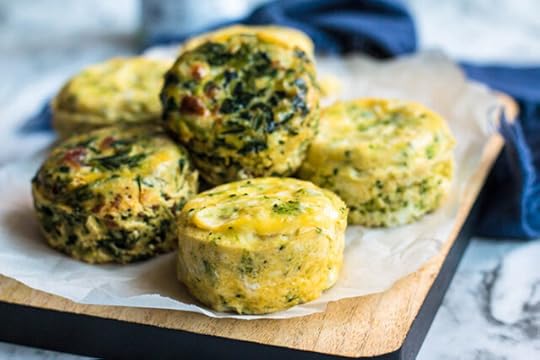 The low-carb community was pretty pumped when coffee shops first started to serve sous vide egg bites. Until then, most breakfast options came between a couple of slices of a bagel or croissant. Coming in around $5 for two little egg bites, it was only a matter of time before people started looking for make-at-home versions.
The low-carb community was pretty pumped when coffee shops first started to serve sous vide egg bites. Until then, most breakfast options came between a couple of slices of a bagel or croissant. Coming in around $5 for two little egg bites, it was only a matter of time before people started looking for make-at-home versions.
Do You Need a Sous Vide to Make Egg Bites?
Let’s first put it out there that food cooked sous vide is delicious. The temperature is so precisely controlled that there’s virtually no risk of overcooking or undercooking, and for the most part, it’s a hands-off cooking method. Still, it’s cost-prohibitive for a lot of kitchens – you’re looking at a couple hundred dollars for a decent system, which is more than the average household wants to spend on an appliance they’ll use only occasionally.
The solution? These adorable little egg bites are not actually made in a sous vide, but instead in an Instant Pot. The end result is a light and fluffy egg bite bursting with flavor. Ideally, these egg bites would be made in a silicone egg mold, but they also turn out well in ½ pint mason jars. If you don’t have an Instant Pot, there is an oven modification below.
This recipe makes 10 egg bites (5 egg bites of each flavor) which are great for an on-the-go breakfast or protein-packed snack. Feel free to experiment with your favorite add-ins.
Instant Pot “Sous Vide” Egg Bites Recipe
Serves: 5
Time in the kitchen: 25 minutes, including 18 minutes cook time
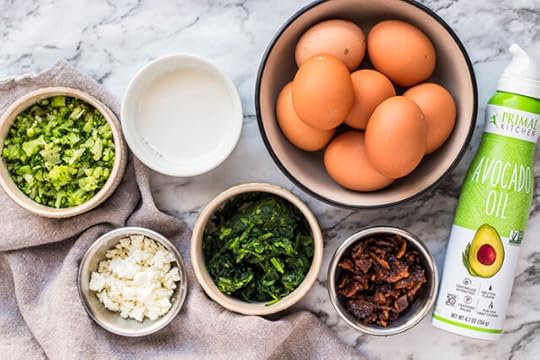
Ingredients
7 large eggs
3 Tbsp. milk of choice (unsweetened and unflavored if you’re using non-dairy milk)
½ cup chopped cooked broccoli florets
1 oz. Crumbled Feta Cheese
3 slices crumbled Cooked Bacon
½ cup Chopped Spinach, cooked and drained well
Salt and Pepper
Primal Kitchen® Avocado Oil Spray
Directions
Combine the eggs, milk and a pinch of salt and pepper. For a fluffier egg bite, swap out the milk for ¼ cup of cottage cheese. Blitz them together in a blender, and separate the beaten eggs evenly into two bowls.
In one bowl, add the chopped broccoli and feta and whisk to combine. In the second bowl, add the crumbled bacon and spinach and whisk to combine.

Liberally spray the insides of your mason jars with Primal Kitchen Avocado Oil spray. Each bowl of egg mixture will make 5 egg bites. Scoop out about ¼ cup of the feta broccoli egg batter into the jars, until the mixture is equally divided between 5. Do the same with the bacon, spinach, and egg mixture. If you are using an egg mold, fill the egg molds until they are a little more than ¾ of the way full.
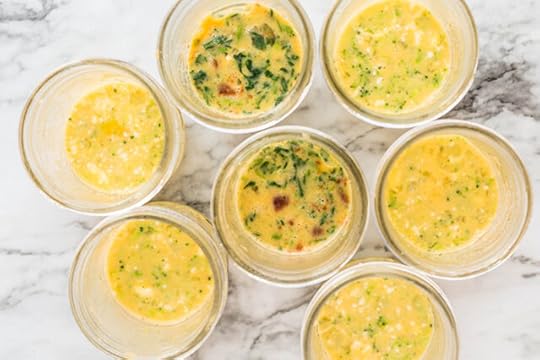 Cover the mouth of each mason jar with a small piece of foil. If you are using an egg mold, cover them with the accompanying lid (if oven safe) or with foil.
Cover the mouth of each mason jar with a small piece of foil. If you are using an egg mold, cover them with the accompanying lid (if oven safe) or with foil.
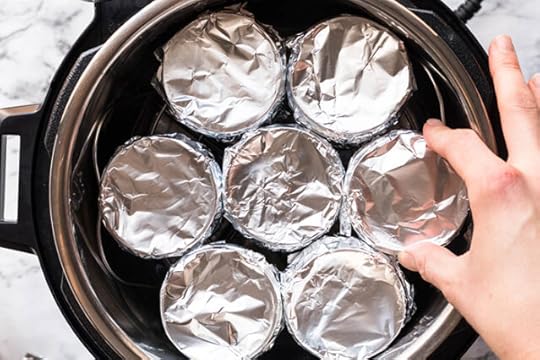
Add 1.25 cups of water to the Instant Pot, and place the metal trivet into the pot. Nestle 5-7 mason jars into the Instant Pot on top of the trivet. Place the lid on the pot and select the “Pressure Cook” option. Set it for 10 minutes at Low Pressure. Once the cooking cycle is over, allow the pressure to naturally release for 6 minutes before moving the nozzle to the vent position. Carefully remove the lid and jars from the Instant Pot and allow them to rest for 1-2 minutes to cool slightly. Carefully run a knife around the egg bite and give the jar a gentle shake to release the egg bite from the jar. Add an additional ¼-½ cup of water to the bottom of the Instant Pot and repeat with the remaining jars.
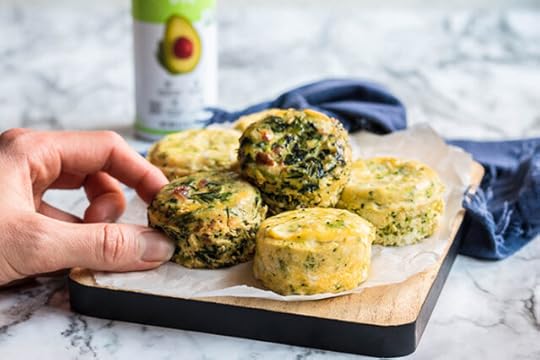
Sous Vide Egg Bites – Oven Method
If you do not have an Instant Pot, you can fill the silicone egg molds and place them in a large baking dish or dutch oven filled with ?-½ full of water. Cover the mold with foil and bake the eggs at 325 degrees for at least 40 minutes, or until the eggs are firm (note that you cannot use mason jars in the oven).
Nutrition Information, per egg bite (recipe makes 10):
Calories: 79
Total Carbs: 0 grams
Net Carbs: 0 grams
Fat: 6 grams
Protein: 6 grams
The post Instant Pot “Sous Vide” Egg Bites Recipe appeared first on Mark's Daily Apple.



May 22, 2020
Weekly Link Love – Edition 82

Research of the Week
The internal, external, and extended microbiomes of hominins.
An “oral health optimized diet” is a low-carb ones.
The immunoregulatory potential of cannabis for infectious diseases.
New Primal Blueprint Podcasts
Episode 424: Dr. Anna Cabeca, DO: Host Elle Russ chats with Dr. Anna Cabeca, an expert on menopause and sexual health.
Primal Health Coach Radio, Episode 61: Laura and Erin talk with Milena Regos, who’s on a mission to save people from hustle culture.
Media, Schmedia
Is meat off the menu?
Interesting Blog Posts
Video chat is not a replacement.
Well, can we?
Social Notes
I had a great time on the Essentially You podcast with Dr. Mariza Snyder, where I gave some simple tips for resetting your metabolism and rebooting your health.
I also had a great time on Dr. Mark Hyman’s The Doctor’s Farmacy podcast, where I talked about the power of keto and metabolic flexibility (among a dozen other topics).
Everything Else
Back when babies didn’t skip leg day.
Robot dog herds New Zealand sheep.
What’s happening with coronavirus in South Asia?
Some good news.
Things I’m Up to and Interested In
Video that blew me away: A hen defends her chicks against a king cobra.
Interesting article on DIY biotech: The Rogue Experimenters.
Reaction video channel I’m enjoying: Reactistan. Highlights include rural Pakistani villagers trying donuts and Mexican food for the first time. “This is so sweet. But who knows what it’s made of.” Agreed, my friend.
Podcast I enjoyed: Chris Smith on the Mark Bovair Podcast talking about how doing nothing but farmer’s walks for 90 days transformed his body.
Question I’m Asking
What are you reading these days?
Recipe Corner
Crispy orange dijon chicken legs.
Strawberry salsa. I’m intrigued.
Time Capsule
One year ago (May 17 – May 23)
Archetypal Resting Positions: How Sitting Like Your Ancestors Could Save Your Health – Sit different.
Does Sleep Quality Really Decline with Age? (Plus, What I Do) – Well, does it?
Comment of the Week
“Mark asks: ‘what is the point of all these observational studies?’
The point is for researchers to do something. I don’t say that in a cynical way, just in an observational way (har-har). Someone needs to write a thesis, then have a career, etc. The sheer quantity of these studies says more about how many people pursue this career path relative to the fruits of their labor, and less about what high-quality research looks like.
They do have some* potential for good. If we ever find that there’s some weird link between covid and broccoli, (or trans fats and heart disease), it will maybe be inspired by these datasets.”
– Great point, Grah.
The post Weekly Link Love – Edition 82 appeared first on Mark's Daily Apple.



May 21, 2020
Staying Motivated While Working Out At Home (Plus a PELOTON Giveaway)
 A lot of people are having a hard time staying motivated to work out while fitness centers and studios are closed. Perhaps you enjoy the social aspect of workout classes or you have a standing appointment to meet your lifting buddy at the gym. Maybe you lost access to your favorite activities as a result of temporary Crossfit box or pool closures. Or, you finally found a coach or trainer you connect with, and regulations mean sessions are on hold.
A lot of people are having a hard time staying motivated to work out while fitness centers and studios are closed. Perhaps you enjoy the social aspect of workout classes or you have a standing appointment to meet your lifting buddy at the gym. Maybe you lost access to your favorite activities as a result of temporary Crossfit box or pool closures. Or, you finally found a coach or trainer you connect with, and regulations mean sessions are on hold.
It’s understandable. Many people recognize that intrinsic motivation (self-motivation) to exercise isn’t going to cut it, so they’ve set up their fitness life around extrinsic motivational (motivation from outside sources) factors – friends, friendly competition, stellar coaching, whatever have you.
That doesn’t have to mean losing all of your progress and starting completely over when your normal routine resumes. Until we’re on the other side of the pandemic, we need to find ways to motivate ourselves to keep up our fitness at home. Here are a few ideas to get you started.
4 Ways to Stay Motivated While Working Out at Home
Set Up an Accountability Group. There’s a fair chance that your former workout tribe is in the same boat as you are, and would love to check in with some familiar faces. Or, your friends and family are craving some social interaction, even if it has to be on-screen. With social media as woven into our lives as it is, it is easier than ever to reach out to your network and your and gym buddies to share successes and encouragement. Set a time, even if it’s only once or twice a week, to discuss what you’ve been doing and champion each others’ efforts.
Use Apps to Compete With Others. There have to be hundreds of apps that facilitate competitions between friends and strangers alike. You can organize or participate in virtual endurance races using the Strava app. My Fitness Pal allows you to add friends and engage in friendly diet and fitness competitions. Peloton equipment and integrated apps offer challenges, achievement badges and new “quests” (based on Instagram clues) that are surprisingly motivating, especially when you can peek in on friends you follow to see what’s going on on their profiles. Primal Kitchen® is giving away a Peloton plus $200 in product! Head over to this page – entry only takes a minute.
Opt for Shorter Workouts and Microworkouts. Your workout doesn’t have to be a full hour of heart-pumping, sweaty hyperactivity. In fact, that can be counterproductive to your goals. Instead, try different formats to get the maximum benefit out of minimum effort. You can do an incredibly effective sprint workout in 10-15 minutes, start to finish. If microworkouts have piqued your interest, keep a resistance band or a few weights on the floor in front of your desk, and rep out a few sets of your favorite resistance moves in between emails throughout the day. You’d be surprised at how the effects of unobtrusive two-minute workouts will add up.
Play More. Every state has some form of regulation, but going outside is fair game. So, get outside. Find an open space to play Ultimate frisbee with your family. Take a bike ride with your kids since they’re home from school. Find a trail that’s open to the public and and hike out to a lake to skip rocks. Movement doesn’t have to follow prescriptive exercise formats, and the more fun you have, the more likely you’ll be to go back for more.
This setback is temporary, and we’ll undoubtedly get back to our preferred flavor of fitness. Sooner? Later? I’m not entirely sure. Until then, being flexible and getting creative will help you optimize your health.
Enjoy the rest of your week, and don’t forget to enter the giveaway for the Peloton Bike and Primal Kitchen haul. It’s an incredible prize package!
The post Staying Motivated While Working Out At Home (Plus a PELOTON Giveaway) appeared first on Mark's Daily Apple.



If You Want Real Change, Start with SMART Goals
 Avoid inflammatory, processed foods. Get plenty of sleep. Move your body on a regular basis. It’s the trifecta of good health. But if this was everything you needed to know, we’d all be metabolically flexible with rock-hard abs and proper blood sugar levels.
Avoid inflammatory, processed foods. Get plenty of sleep. Move your body on a regular basis. It’s the trifecta of good health. But if this was everything you needed to know, we’d all be metabolically flexible with rock-hard abs and proper blood sugar levels.
That’s because knowing what to do and how to do it are two entirely different things.
Too often, I’ll get messages from new clients saying they’re ready to drop all carbs, get better sleep, start intermittent fasting, cut out fast food, buy blue blockers for everyone in their family, workout more…
In other words, they’re all in.
You’d think I’d be super psyched about their level of motivation. But to me, it means they need help reeling it in. My job as a health coach is to show people how to get from point A to point B, and having broad, sweeping goals with no clear direction doesn’t work. Ever.
Instantly download your FREE guide: The Primal and Keto Guide to Dining Out
How to Make Goals Achievable
To really succeed, you’ve got to know what you’re changing and how to measure your success. Want to sleep more? Eat more veggies? Exercise more? Yep, me too. But real goal setting requires getting smart about it. And that’s where SMART goals come in. Originally credited to Peter Drucker in his 1954 book, The Practice of Management as well as George Doran and Dr. Edwin Lock, and used by everyone from professors to Primal Health Coaches, SMART is an acronym that stands for:
• Specific. What specifically do want to achieve?
• Measurable. How will you quantify your results?
• Attainable. Do you have the tools to make this happen?
• Relevant. Does this goal align with your lifestyle?
• Timely. What’s your deadline on this goal?
NOTE: If you’ve seen different versions of this, just know that there are a few different variations out there. Sometimes the ‘S’ stands for significant or simple, the ‘M’ for meaningful or motivating, the ‘A’ for achievable or agreed upon, the ‘R’ for realistic or results-based, and the ‘T’ for time-sensitive or time-based.
Examples of SMART Goals
Want a better night’s sleep? Your SMART goal might be:
S: To get 7-9 hours of sleep per night.
M: I’ll use a sleep tracking app to measure my progress.
A: I’ll wear my blue blockers for any screen time in the evenings.
R: Being in bed by 9:30pm is doable for me.
T: Every night until my vacation in the fall.
Want to work out more? Try:
S: I will walk 3 miles every morning.
M: I’ll track it with my Garmin.
A: GPS watch? Check. New sneakers? Check.
R: I have to walk my dog in the morning anyway, so this works.
T: For the next 4 weeks.
Remember, SMART goals are designed to be quantifiable and have a defined end point, which helps you get clear about what you’re doing to reach that goal and how you’ll know if you’re successful or not. For example, in a 2005 study,1 researchers worked with 1785 obese men and women seeking treatment for weight loss. Using different goal setting approaches, they found that nearly 52% of participants with unrealistic and unattainable weight loss expectations had discontinue treatment after one year.
The truth is, it’s easy to get discouraged, especially with things that are more long-term. That’s why I always use SMART goals with my clients. But you don’t have to work with a health coach to take advantage of this approach. Follow my How to Write a SMART Goal guide below to get started on your own.
How to Write a SMART Goal
Here’s a sample of the goal setting worksheets I use with my clients. You can highlight this section, right-click, and print to fill out your own SMART Goals, or you can opt to follow the format on a blank sheet in your journal.
SMART Goals
1. Make it Specific. This is the time to get as clear as possible. The more you define your goal, the easier it will be to understand what it will take to get there. Also, be aware of using non-committal phrases like “I want to” or “I think I can”. Get concrete with your goals, describing them in a percentage, frequency, or number.
Write your S here: _____________________________________________________
2. Make it measurable. Adding quantifiable criteria to your goal allows you to measure your success in a tangible way. How else will you know if you’re making progress? Having a goal that’s measurable gives you the evidence that what you’re doing is working, and it’s an easy way to ward off feeling overwhelmed by larger goals. Plus, there are tons of apps for measuring everything from macros to miles.
Write your M here: ______________________________________________________
3. Make it attainable. Keep in mind that your goal should also be doable. It’s okay to push the boundaries here and there, but if you’re thinking you want to run a marathon in 3 weeks or drop 50 pounds in a month, you might want to revisit your goal so that it’s in the realm of what’s possible. The idea is to choose something that feels attainable with the right effort, commitment, and available resources.
Write your A here: _______________________________________________________
4. Make it relevant. Relevance means that it aligns with other aspects or longer-term goals of your life. How does it fit within the big picture? How does it impact or contribute to your household, your work environment, or your family responsibilities? Think about why you’re setting this goal now and why it’s important to you.
Write your R here: _______________________________________________________
5. Make it timely. While I’m not a fan of dropping pounds for an event or summer or bikini body or whatever, having a deadline can set you up for success. An end-date provides the motivation to stick with it. It also keeps you from being too unrealistic with your goal. Even if you plan on eating paleo or sleeping 8 hours a night forever, choosing an end date will give you the parameters to know if you were successful or not.
Write your T here: _______________________________________________________
Why Use SMART Goals?
Think back on the health goals you’ve had in the past. Maybe you weren’t as successful as you would have liked. Or maybe you’re a pro goal setter and knocked it out of the park. For those of you who feel like you’re working super hard and seeing zero progress, I want you to know that there’s a way to be smarter about reaching your goals. And it starts with these five steps:
• Make it specific.
• Make it measurable.
• Make it attainable.
• Make it relevant.
• Make it timely.
References https://iris.unimore.it/retrieve/handle/11380/1170579/210096/Obes%20Res%202005.pdf
The post If You Want Real Change, Start with SMART Goals appeared first on Mark's Daily Apple.



May 20, 2020
9 Worthy Alternatives to Back Squats (No Barbell Required)
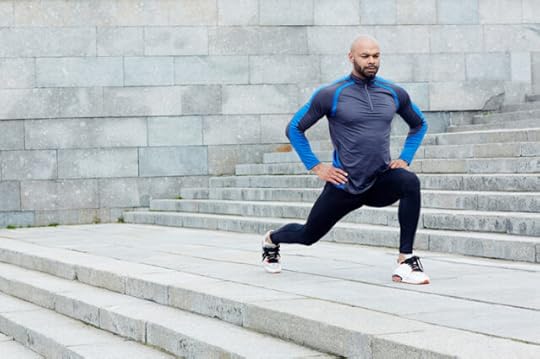 As great as back squats are for strength, general fitness, and body composition, sometimes they just don’t work for a person. Maybe they cause knee, shoulder, or wrist pain. Maybe someone’s body proportions aren’t conducive to proper back squatting. Maybe their legs are too long to achieve good depth without compromising position. While there are dozens of articles imploring you to mobilize this or that joint and work out the kinks in this or that muscle so that the back squat will work, and those can be very informative and helpful, some people just don’t want to back squat. For whatever reason, it doesn’t work for them.
As great as back squats are for strength, general fitness, and body composition, sometimes they just don’t work for a person. Maybe they cause knee, shoulder, or wrist pain. Maybe someone’s body proportions aren’t conducive to proper back squatting. Maybe their legs are too long to achieve good depth without compromising position. While there are dozens of articles imploring you to mobilize this or that joint and work out the kinks in this or that muscle so that the back squat will work, and those can be very informative and helpful, some people just don’t want to back squat. For whatever reason, it doesn’t work for them.
Especially now, when gyms are closed and it’s difficult to get your hands on a barbell, you might be looking for alternatives to back squats that will keep your legs just as strong.
Plenty of other knee flexion exercises are worth doing. Let’s take a look at some of the best alternatives.
9 Back Squat Alternatives You Can Do At Home
Air squats
Goblet squats
Front squats
Band Zercher squats
Bulgarian split squats
Resistance band split squats
Step ups
Walking lunges and Reverse Lunges
Tempo squat jumps
1. Air Squats

Don’t underestimate the efficacy of the simple bodyweight air squat. It’s great for mobility and surprisingly metabolically demanding.
To do air squats, start with your feet shoulder width apart. Bend at the knee, and come to a low “seat” in an imaginary chair. Keep a straight line between your tailbone and your head. Don’t think you can work your quads without heavy weights? Do a few high-rep sets of air squats and you’ll feel it. If you’d like an extra challenge, wearing a weighted vest or holding weights at your sides will add some extra oomph.
2. Goblet Squats
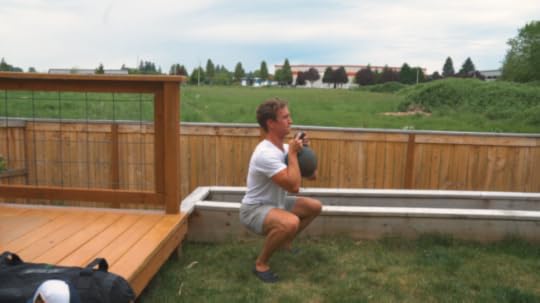 Goblet squats are easier on most bodies than back squats for two reasons: less weight is used (because you have to hold it in your hands at chin level) and they promote a more “natural” squatting technique. To perform a goblet squat, you hold a weight (kettlebell, weight plate, dumbbell, small child) at chin level, stay tall, and squat down between your legs while maintaining an upright torso. Many seasoned strength coaches use the goblet squat to teach beginners how to squat because it’s so intuitive.
Goblet squats are easier on most bodies than back squats for two reasons: less weight is used (because you have to hold it in your hands at chin level) and they promote a more “natural” squatting technique. To perform a goblet squat, you hold a weight (kettlebell, weight plate, dumbbell, small child) at chin level, stay tall, and squat down between your legs while maintaining an upright torso. Many seasoned strength coaches use the goblet squat to teach beginners how to squat because it’s so intuitive.
That said, there are some extra details to keep in mind:
Tuck your elbows against your body. This creates a more stable “shelf” of support for the weight.
Keep your chest up.
Push your knees out.
Since you won’t be pushing heavy weights with the goblet squat, focus on higher reps and more overall volume. If things get dicey, dropping the weight in a goblet squat is way easier than dropping a barbell sitting on your back.
3. Front Squats
 To me, front squats have always felt more natural than back squats. There’s less thinking about what your joints are doing and which muscle groups you’re supposed to be activating. You just squat with a weight in the front rack position and the rest follows. It’s hard to mess up and round your lower back because if you lean too far forward during a front squat, you’ll just dump the weight.
To me, front squats have always felt more natural than back squats. There’s less thinking about what your joints are doing and which muscle groups you’re supposed to be activating. You just squat with a weight in the front rack position and the rest follows. It’s hard to mess up and round your lower back because if you lean too far forward during a front squat, you’ll just dump the weight.
According to a 2009 study on front and back squats in trained individuals, front squats exert fewer compressive forces on the knee and “may be advantageous compared with back squats for individuals with knee problems such as meniscus tears, and for long-term joint health.”1 Furthermore, front squatting less weight resulted in identical muscle activation as back squatting more weight.
The more upright posture inherent to front squats is also good for people with lower back pain by creating less shear stress on the vertebrae. An important cue to keep in mind during the front squat is “elbows up.” This creates a strong, stable shelf for the bar and cues the torso to stay firm and unyielding to forward tilt. If your elbows dip, the rest will soon follow.
No bar? No problem. Grab two weights and hold them just above your shoulders, or hold a sandbag at chest level.
4. Band Zercher Squats
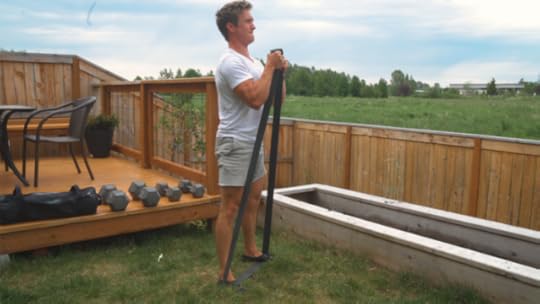 For resistance band Zercher squats, hold the band just below your chin, just as you would with a goblet squat. The difference here is that the hardest part is at the top of the movement.
For resistance band Zercher squats, hold the band just below your chin, just as you would with a goblet squat. The difference here is that the hardest part is at the top of the movement.
If you have a bar, you can do a traditional bar Zercher squat, where the bar sits in the crook of your inner elbows about belly-high as you squat. This places more emphasis on the core and glutes. Anecdotally, people with knee pain during normal squats seem to do well with Zercher squats. As for the weight resting on the arms, it hurts at first, but you get used to it. And if you don’t, you can always use a pad or a rolled up towel to dampen the pain.
They kind of force good form, too. As you squat down with the bar in the crook of your arm, your elbows fit neatly between your knees and prevent them from buckling inward. As you come up, be sure to thrust your hips fully forward at the top and stand up straight.
Initiate bar Zerchers in one of two ways:
The more involved method – Deadlift the bar to just above the knee. Squat down, carefully letting the bar rest on your lower quads. Slip your inner elbows underneath the bar and stand back up.
The easier method – Place the bar on a squat rack set to about waist height or a bit higher. Slip your inner elbows underneath the bar and stand back up.
5. Bulgarian Split Squats
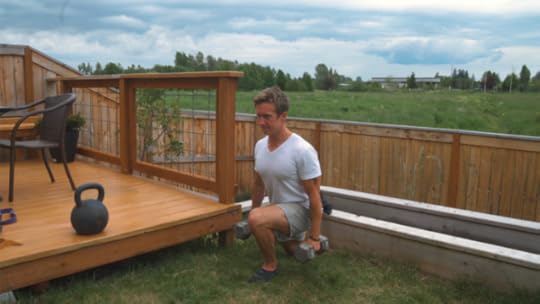 Several years ago, a strength coach named Mike Boyle made waves across the Internet by recommending against back squats and promoting Bulgarian split squats in their place. The split squat, he said, allows fuller loading of the legs being worked by removing the back from the equation. In a Bulgarian split squat, you place one foot behind you on an elevated surface and squat down until the back knee touches the floor (or a pad resting on the floor), keeping the weight on the foot in front of you. Getting your balance right can be tricky at first but once you’re comfortable it’s a great way to isolate individual legs without taxing your back. Many a trainee has woken up with throbbing glutes after a day of split squats.
Several years ago, a strength coach named Mike Boyle made waves across the Internet by recommending against back squats and promoting Bulgarian split squats in their place. The split squat, he said, allows fuller loading of the legs being worked by removing the back from the equation. In a Bulgarian split squat, you place one foot behind you on an elevated surface and squat down until the back knee touches the floor (or a pad resting on the floor), keeping the weight on the foot in front of you. Getting your balance right can be tricky at first but once you’re comfortable it’s a great way to isolate individual legs without taxing your back. Many a trainee has woken up with throbbing glutes after a day of split squats.
Play with the height of the surface your back foot is resting on. If it’s too high, you’ll place stress your back. Lower the height if you find your back arching or your torso tilting too far forward. Stacking a few weight plates about six to eight inches high is good enough for most people.
6. Resistance Band Split Squats
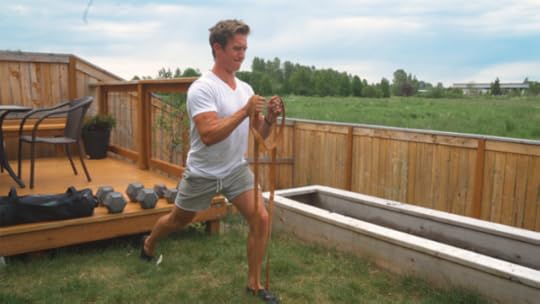
As with weighted split squats, resistance band split squats start by placing one foot behind you on an elevated surface and squatting down until the back knee touches the floor (or a pad resting on the floor), keeping the weight on the foot in front of you. Instead of weights, you’ll grip a resistance band at chest height.
7. Step-ups
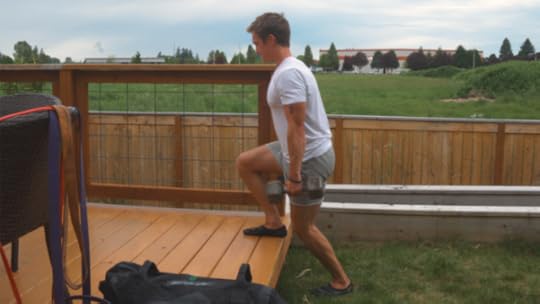 Step-ups are fun. And they’re different than every other exercise in this post because they begin with the concentric portion of the lift. Most exercises begin with the eccentric portion. When you start with the eccentric portion, you’re dreading the concentric portion the whole way down. When you start with the concentric portion, the hard part is over right away and you just have to control the descent. There’s also no bounce to use as a crutch — just like the first deadlift of the set. Some people hate them, some love them. They’re definitely worth a shot and are a fantastic way to hit the glutes.2
Step-ups are fun. And they’re different than every other exercise in this post because they begin with the concentric portion of the lift. Most exercises begin with the eccentric portion. When you start with the eccentric portion, you’re dreading the concentric portion the whole way down. When you start with the concentric portion, the hard part is over right away and you just have to control the descent. There’s also no bounce to use as a crutch — just like the first deadlift of the set. Some people hate them, some love them. They’re definitely worth a shot and are a fantastic way to hit the glutes.2
To target quads, hamstrings, and glutes, use a surface high enough that your knee is at 90° when you step onto it. The higher the box, the more glute and hamstring you’ll hit. Lower boxes will focus more on the quads. Try not to push with the off foot. If you find yourself pushing off despite best efforts, dorsiflex the off foot and touch down only with the heel.
8. Walking Lunges and Reverse Lunges
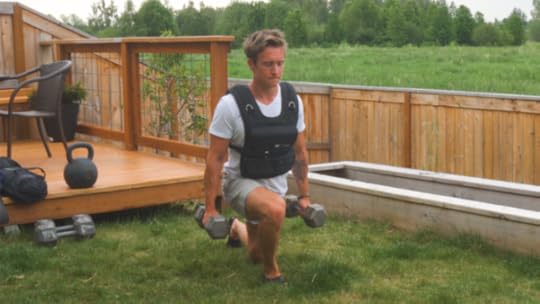 My go-to exercise when dealing with substandard hotel gyms is a few sets of walking lunges while carrying the heaviest dumbbells they’ve got. There’s something special about the combination of moving through space and lifting that adds a whiff of complexity and increases the training adaptations.
My go-to exercise when dealing with substandard hotel gyms is a few sets of walking lunges while carrying the heaviest dumbbells they’ve got. There’s something special about the combination of moving through space and lifting that adds a whiff of complexity and increases the training adaptations.
Lunges are relatively easy on the knees for many people who get knee pain during back squats. For others, it’s the opposite (but this post isn’t really intended for them). If you have problems with lunges, play around with the torso angles. Turning the movement into more of a single leg hip hinge by slightly leaning forward (shoulders over knees) can alleviate unpleasant forces to the knee.
To make them easier, forego the weights. To make them more challenging, add hand weights and a weighted vest if you feel like you need to ramp it up.
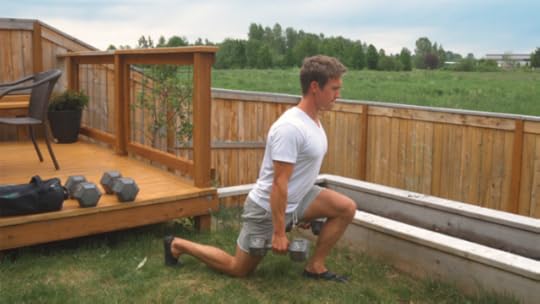 Walking lunges are awesome, but they require magnificent balance. And if you’re pushing heavy weight, any minor mistake during the initial descent can send you and the weight tumbling. They also require a lot of room. Reverse lunges are generally safer, more stable, and they don’t require much space (because you do them in place).
Walking lunges are awesome, but they require magnificent balance. And if you’re pushing heavy weight, any minor mistake during the initial descent can send you and the weight tumbling. They also require a lot of room. Reverse lunges are generally safer, more stable, and they don’t require much space (because you do them in place).
Instead of taking steps forward, you will step backward into your lunge and return to standing for each rep.
9. Tempo Squat Jumps
Start as you would an air squat, feet shoulder-width apart. Over a count of four, lower into a squat position. Explosively jump up, land soft, and lower your body back into a squat position, taking a full count of four to get there. You can watch Brian demonstrate this and all of the above squat alternative movements in this video.
That’s it for today, everyone. If you feel like you’re missing out on the barbells at the gym, I hope you’ve found at least a couple exercises in today’s post to fill the void — and get you a fantastic workout in the process.
Thanks for reading. What are your favorite alternatives to the back squat?

References http://www.ncbi.nlm.nih.gov/pubmed/19002072http://www.ncbi.nlm.nih.gov/pubmed/22237139
The post 9 Worthy Alternatives to Back Squats (No Barbell Required) appeared first on Mark's Daily Apple.



Mark Sisson's Blog
- Mark Sisson's profile
- 199 followers









